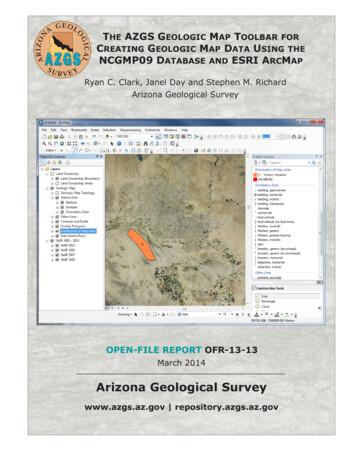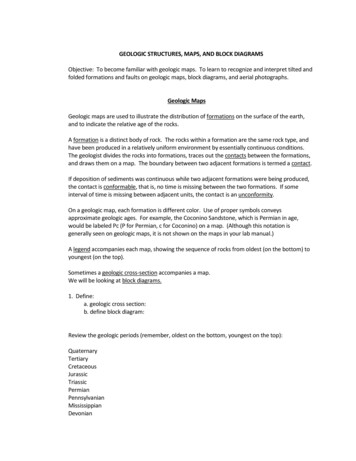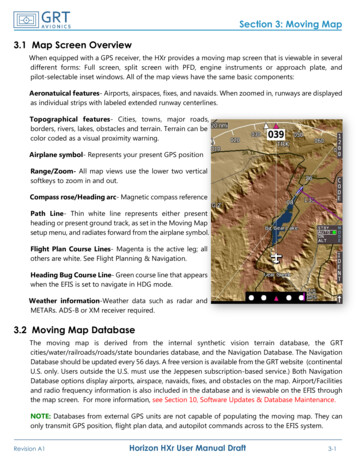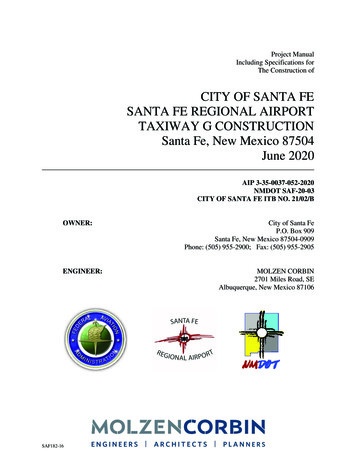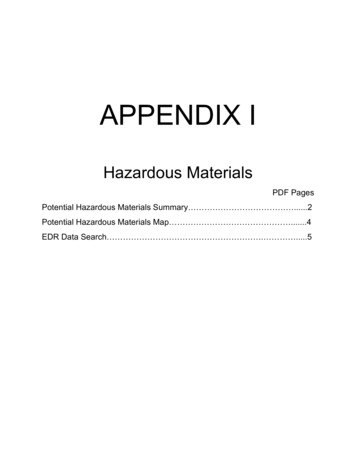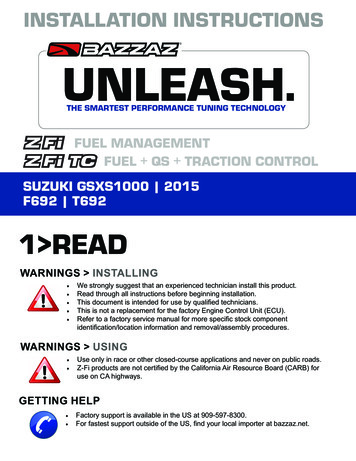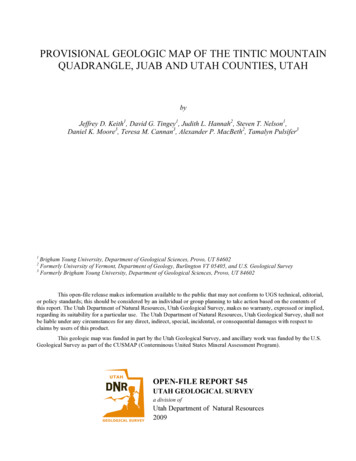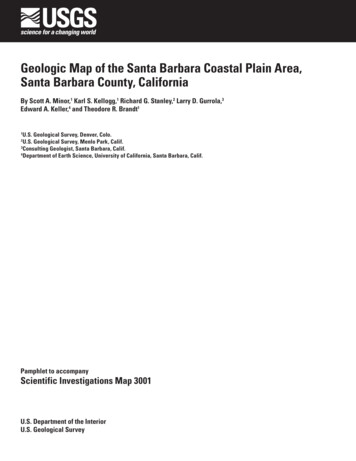
Transcription
Geologic Map of the Santa Barbara Coastal Plain Area,Santa Barbara County, CaliforniaBy Scott A. Minor,1 Karl S. Kellogg,1 Richard G. Stanley,2 Larry D. Gurrola,3Edward A. Keller,4 and Theodore R. Brandt1U.S. Geological Survey, Denver, Colo.U.S. Geological Survey, Menlo Park, Calif.3Consulting Geologist, Santa Barbara, Calif.4Department of Earth Science, University of California, Santa Barbara, Calif.12Pamphlet to accompanyScientific Investigations Map 3001U.S. Department of the InteriorU.S. Geological Survey
Geologic Map of the Santa Barbara CoastalPlain Area, Santa Barbara County,CaliforniaBy Scott A. Minor,1 Karl S. Kellogg,1 Richard G. Stanley,2 Larry D. Gurrola,3Edward A. Keller,4 and Theodore R. Brandt1U.S. Geological Survey, Denver, Colo.U.S. Geological Survey, Menlo Park, Calif.3Consulting Geologist, Santa Barbara, Calif.4Department of Earth Science, University of California, Santa Barbara, Calif.12Pamphlet to accompanyScientific Investigations Map 3001U.S. Geological SurveyU.S. Department of the Interior
U.S. Department of the InteriorKEN SALAZAR, SecretaryU.S. Geological SurveySuzette M. Kimball, Acting DirectorU.S. Geological Survey, Reston, Virginia: 2009For product and ordering information:World Wide Web: http://www.usgs.gov/pubprodTelephone: 1-888-ASK-USGSFor more information on the USGS--the Federal source for science about the Earth, its natural and living resources,natural hazards, and the environment:World Wide Web: http://www.usgs.govTelephone: 1-888-ASK-USGSAny use of trade, product, or firm names is for descriptive purposes only and does not imply endorsement by theU.S. Government.Although this report is in the public domain, permission must be secured from the individual copyright owners toreproduce any copyrighted materials contained within this report.Suggested citation:Minor, S.A., Kellogg, K.S., Stanley, R.G., Gurrola, L.D., Keller, E.A., and Brandt, T.R., 2009, Geologic Map of the SantaBarbara Coastal Plain Area, Santa Barbara County, California: U.S. Geological Survey Scientific Investigations Map3001, scale 1:25,000, 1 sheet, pamphlet, 38 p.
iiiContentsIntroduction.1Previous Mapping.1Present Mapping.2Geologic Summary.2Structural Framework.3Fault Kinematic Constraints.6Timing of Deformation.7Cenozoic Geologic History.8Acknowledgments.9Description of Map Units.10References Cited.35
ivConversion FactorsTo convertMultiply byTo obtainmeter (m)3.281foot (ft)kilometer (km)0.6214mile (mi)square kilometer (km2)0.3861square mile (mi2)
IntroductionThis report presents a newly revised and expanded digitalgeologic map of the Santa Barbara coastal plain area (fig. 1)at a compilation scale of 1:24,000.1 The map depicts thedistribution of bedrock units and surficial deposits and associated deformation underlying and adjacent to the coastal plainwithin the contiguous Dos Pueblos Canyon, Goleta, SantaBarbara, and Carpinteria 7.5-minute quadrangles (fig. 2). Thenew map supersedes an earlier preliminary geologic map ofthe central part of the coastal plain (Minor and others, 2002;revised 2006) that provided coastal coverage only within theGoleta and Santa Barbara quadrangles. In addition to newmapping to the west and east, geologic mapping in parts ofthe central map area has been significantly revised from thepreliminary map compilation—especially north of downtown Santa Barbara in the Mission Ridge area—based onnew structural interpretations supplemented by new biostratigraphic data. Several new map units recognized in theareas of expanded mapping are described. Abundant newbiostratigraphic and biochronologic data based on microfossilidentifications are presented in expanded unit descriptions ofthe marine Neogene Monterey and Sisquoc Formations. Sitespecific fault kinematic observations embedded in the digitalmap database are more complete owing to the addition of slipsense determinations. Finally, the present report includes anexpanded and refined summary of stratigraphic and structuralobservations and interpretations that are based on the composite geologic data contained in the new map compilation (seeGeologic Summary below). The digital geologic database forthis map is available on the Internet at: http://pubs.usgs.gov/sim/3001.The Santa Barbara coastal plain is located in the westernTransverse Ranges physiographic province along an east-westtrending segment of the southern California coastline about100 km northwest of Los Angeles (fig. 1). The coastal plainis defined here as the relatively low elevation (lower than 150to 300 m, depending on location), low- to moderate-reliefpiedmont that generally slopes gently seaward from the steepSanta Ynez Mountains range front on the north to the SantaBarbara Channel on the south (figs. 3, 4, and 5). The maximum width of the coastal plain is about 7 km near the citiesof Santa Barbara and Goleta, and narrows to 3 km or lessseveral kilometers west of Goleta and near Carpinteria (figs.2 and 6). The coastal plain surface includes several mesasand hills (figs. 3, 4, and 6) that are geomorphic expressions ofpotentially active folds and partly buried oblique and reversefaults of the Santa Barbara fold and fault belt that transects thecoastal plain (SBFFB, fig. 2) (Keller and Gurrola, 2000; Gurrola1The map and database were compiled at a scale of 1:24,000, but theprinted map scale is 1:25,000 due to printing press size limitations.and others, 2001). [Note: Although Keller and Gurrola (2000)and Gurrola and others (2001) named the structural belt the“Santa Barbara Fold Belt”, we refer to it as a “fold and faultbelt” due to the common presence of both surficial folds andfaults along it.] Strong earthquakes have occurred offshorewithin 10 km of the Santa Barbara coastal plain in 1925 (6.3magnitude), 1941 (5.5 magnitude), and 1978 (5.1 magnitude).These, and numerous smaller seismic events located beneathand offshore of the coastal plain, likely occurred on reverseoblique-slip faults that are similar to, or continuous with,Quaternary reverse faults crossing the coastal plain (Yerkesand Lee, 1987). Thus, faults of the SBFFB pose a significantearthquake hazard to the approximately 200,000 people livingwithin the major coastal population centers of Santa Barbara,Goleta, and Carpinteria. In addition, numerous Quaternarylandslide deposits along the steep southern flank of theSanta Ynez Mountains (Bezore and Wills, 2000) indicate thepotential for continued slope failures and mass movements indeveloped areas. Folded, faulted, and fractured sedimentaryrocks in the subsurface of the coastal plain and adjacent SantaBarbara Channel are sources and reservoirs for economic depositsof oil and gas (Tennyson and Isaacs, 2001), some of which arecurrently being extracted offshore. Shallow, localized, sedimentaryaquifers underlying the coastal plain provide limited amounts ofwater for the urban areas, but the quality of some of this groundwater is compromised by coastal salt-water contamination(Upson, 1951; Muir, 1968). The present map compilation provides a set of uniform geologic digital coverages and shape filesthat can be used for analysis and interpretation of these and othergeologic hazards and resources in the coastal plain region.Previous MappingThe first geologic map produced in the Santa Barbaracoastal plain area was a 1:62,500-scale map of the Summerland Oil District by Arnold (1907). Willis (1925) producedthe first fault map of the entire coastal plain area at a scale of1:62,500 as part of an investigation of the large Santa Barbaraearthquake of 1925. A second early fault map of the coastalplain (providing coverage as far east as Santa Barbara) wasproduced by Hill (1932) at a scale of 1:125,000 in conjunction with a structural study of faulting in the area. The earliestsystematic geologic mapping in the study area was by Upson(1951), who mapped the coastal plain region in reconnaissance at a scale of 1:31,680 as part of a water-resource study,and by Lian (1954), who mapped the eastern Mission RidgeMontecito area at a scale of 1:62,500. Thomas W. Dibblee, Jr.,(1966) produced the first comprehensive, detailed geologicmaps of the Santa Barbara coastal plain region. These mapsprovided geologic coverage of the west half of the map area ata scale of 1:62,500 and of the east half at a scale of 1:31,680.
2 Geologic Map of the Santa Barbara Coastal Plain Area, Santa Barbara County, CaliforniaMuir (1968) compiled a simplified geologic map of the SantaBarbara-Montecito area as part of a reconnaissance ground-waterstudy that was based mainly on the earlier mapping of Upson andDibblee. Hoover (1978) mapped the geology of the city of SantaBarbara at a scale of 1:12,000 to evaluate geologic hazards in theSanta Barbara area. As an aid to constructing subsurface geologicinterpretations of the coastal-plain region, Olson (1982) produceda 1:24,000-scale geologic map compilation of the area that waslargely based on the previous mapping listed above. The ThomasDibblee Foundation published separate geologic maps of theCarpinteria, Santa Barbara, Dos Pueblos, and Goleta 7.5-minutequadrangles (Dibblee, 1986a, 1986b, 1987a, 1987b) at a scaleof 1:24,000, which were largely based on geologic mappingcompiled for the earlier Dibblee (1966) maps. The California Geological Survey (formerly California Division of Mines and Geology) produced 1:24,000-scale landslide inventory and landslidepotential maps of the Santa Barbara coastal plain region (Bezoreand Wills, 2000). Finally, our recent preliminary geologic mapof the central part of the coastal plain (Goleta and Santa Barbaraquadrangles) (Minor and others, 2002; revised 2006) providedan initial revised geologic depiction of the coastal region andformed a framework for producing the present map.Present MappingThe present geologic compilation of the Santa Barbaracoastal plain, along with the preliminary compilation thatpreceded it (Minor and others, 2002), comprise new, originalmapping based on field and aerial-photograph geologic observations and interpretations made at the ground surface or inshallow surface excavations, supplemented by new biostratigraphic identifications. In keeping with this surficial theme,and owing to the questionable or conflicting stratigraphicpicks in many of the petroleum industry drilling logs in themap area, no geologic cross sections are presented herein.The recently revised geologic time scale of the U.S. Geological Survey Geologic Names Committee (2007) was adoptedfor assigning geologic ages to map units in this report. In thedescription of map units, sedimentary lithologic terms androck naming conventions are largely from Williams and others(1982).The present mapping results were achieved through thecollaborative efforts of geologists with the U.S. GeologicalSurvey (USGS) Southern California Areal Mapping Project(SCAMP) (Minor, Kellogg, and Stanley) and the tectonicgeomorphology research group at the University of Californiaat Santa Barbara (Gurrola and Keller). Field-based geologicmapping and associated investigations in the map area wereconducted chiefly in 2000 through 2005. Minor and Kelloggconducted most of the geologic mapping inland of the seacliffs, with Minor’s efforts focused on the coastal piedmontand lower flanks of the Santa Ynez Mountains in the Goleta,Santa Barbara, and Carpinteria quadrangles and Kellogg’smapping concentrated in the Dos Pueblos quadrangle and themore mountainous, northern parts of the Goleta and Carpinteria quadrangles. Minor also conducted most of the faultkinematic observations and measurements in the map area.Stanley chiefly mapped and documented stratigraphic detailsof the Miocene and Pliocene marine rocks exposed along thesea cliffs in all four of the component 7.5-minute quadrangles.Earlier and concurrent mapping and geochronologic, geomorphic, and paleoseismic investigations of locally deformedcoastal Quaternary deposits and marine terraces by Gurrolaand Keller provided a working model of the Quaternary stratigraphic framework and structural style on the coastal plain,which, in turn, significantly influenced our geologic interpretations during the mapping campaign. T.R. Brandt assistedin the design and editing of the GIS database and performeddatabase integration.Although our new geologic compilations of the SantaBarbara coastal plain area broadly resemble the earlier Dibblee(1966, 1986a, 1986b, 1987a, 1987b) mapping that has servedas the principal geologic map reference in the area, theydiffer significantly in the amount of stratigraphic and structural detail and the geologic interpretations and map depictionsthat result from this detail. In particular, new biostratigraphicand (or) lithologic criteria are established for differentiaing theSisquoc Formation and subunits of the Monterey and SespeFormations, resulting in marked changes in the mappedpositions of contacts for these units. The present compilationincludes a more detailed description, differentiation, and mapping of upper Pliocene and Pleistocene marine and nonmarineunits that bear on the Quaternary tectonic uplift and deformational history of the coastal plain region and the attendantinterplay of marine and continental deposition. Structures aremapped in considerably greater detail than on the Dibbleemaps, resulting in a more thorough and, in places, distinctdocumentation of faults and folds in Quaternary depositsunderlying the coastal plain. Numerous fault attitude andkinematic data acquired during the present mapping campaignprovide new constraints on the geometry and movement history of both mapped and outcrop-scale faults.Geologic SummaryThe western Transverse Ranges consist mainly of variablydeformed marine and nonmarine sedimentary rocks and deposits that range in age from Jurassic to the present. These stratarecord a long history of continental-margin sedimentation, anddeposits as young as middle Pleistocene record considerableprotracted deformation that includes Neogene and Quaternarytranspressional faulting, folding, and clockwise vertical-axisrotations of crustal blocks (for example, Dibblee, 1966, 1982;Hornafius and others, 1986; Namson and Davis, 1988;Luyendyk, 1991; Dickinson, 1995; Gurrola and others, 2001).A dramatic result of this deformation is the prominent SantaYnez Mountains directly north of the Santa Barbara coastal
Structural Framework 3plain (fig. 5), which were uplifted along a large homoclinal toanticlinal structure beginning in the Pliocene (Dibblee, 1982).In the map area, the oldest stratigraphic units consist ofEocene resistant, southward-dipping to overturned, mostlymarine sedimentary rocks along the south flank of the SantaYnez Mountains uplift, which form a backdrop of prominenthogbacks and cuestas adjacent to the Santa Barbara coastalplain (fig. 5). Less resistant but similarly deformed, Oligocenethrough Pliocene terrestrial and marine sedimentary rocks areexposed in the lower Santa Ynez foothills and in the coastalhills and sea cliffs farther south (fig. 7). Moderately faultedand folded or warped Pleistocene marine and terrestrial sediments underlie many of the hills and mesas on the coastalplain (figs. 8, 9, and 10), and undisturbed uppermost Pleistocene and Holocene surficial deposits directly underlie much ofthe low-lying coastal plain area and are locally present alongthe lower flanks of the Santa Ynez Mountains.Details regarding the structural framework, fault kinematic observations, and timing of deformation in the SantaBarbara coastal plain area are given in the sections below.These are followed by a summary of the Cenozoic geologichistory of the area that is based on mapped structural andstratigraphic relations described below and in the Descriptionof Map Units, supplemented by previously reported regionalgeologic observations and interpretations.Structural FrameworkStructurally, the Santa Barbara coastal plain area isdominated by the Santa Barbara fold and fault belt (SBFFB)and the overlapping Santa Ynez Mountains uplift (fig. 2). TheSBFFB is an east-west-trending zone of potentially activefolds and partly blind oblique-slip reverse and thrust faults thatspans the entire coastal plain and widens northwestward intothe lower southern flank of the Santa Ynez Mountains (figs. 2and 11) (Keller and Gurrola, 2000; Gurrola and others, 2001).The dominant trend of individual structures within the belt iswest-northwest–slightly oblique to the trend of the overall foldand fault belt (figs. 2 and 11). Two major fault systems on thecoastal plain that partly define this structural trend are the Mission Ridge fault zone north of Montecito and Santa Barbara,and the Arroyo Parida fault located on the north side of thelower ridge north of Carpinteria. A third major fault system isthe More Ranch, which trends east-northeast across the coastalplain oblique to the SBFFB. Other notable west-northweststriking faults of the SBFFB on the coastal plain are, from eastto west, the Carpinteria, Rincon Creek, Loon Point, OrtegaHill, Lagoon, Rocky Nook, Mesa, Lavigia, Foothill Road, SanPedro, Carneros, El Encanto, and Isla Vista faults (fig. 11).The 11-km-long and 0.6- to 1.2-km-wide Mission Ridgefault zone is expressed by as many as three, dominantly southside-up, partly blind, reverse-dextral and reverse-sinistraloblique-slip (based on slickenlines) fault strands and adjacent(on south side) anticlinal upwarps that deform units as youngas late Pleistocene (Qoa). This broad fault zone has subtle todramatic geomorphic expression in the form of fault and foldscarps and upwarps that culminates in the 150- to 200-m-highMission Ridge anticline upwarp north of downtown SantaBarbara (fig. 4). In contrast, the Arroyo Parida fault consistsof a single fault strand that mostly displaces Oligocene ageand older bedrock units (Tspm, Tspl, Tcw) in the map area,but youthful movement is suggested by sinistral deflectionsof stream channels where they cross the fault trace (Gurrolaand others, 2001) and by offset late Pleistocene fluvial terraces(Qia) along Santa Monica Creek north of Carpinteria and 30km farther east near the end of the Arroyo Parida fault in theOjai Valley area (Rockwell and others, 1984). The sinistralstream deflections are consistent with sinistral strike-slip slickenlines observed along the Arroyo Parida fault; however, thefault, like many other SBFFB faults, probably has a complexslip history including early normal-slip and later reverseoblique, down-to-the-north movement (see fault kinematicdiscussion below).The More Ranch fault system, which spans about 20km of the central and western coastal plain (fig. 3), strikesanomalously east-northeast obliquely (40 to 60 angle) acrossthe dominant west-northwest structural grain of the fold andfault belt (fig. 11). Only a few other, relatively small tracelength faults strike northeast similar to the More Ranch in thecoastal plain area, and only one of these—the Fernald Pointfault in the eastern map area—may have a similar magnitudeof displacement. The More Ranch fault system consists of fivedistinct parts: (1) an eastern right-stepping en echelon segment that tips out on the crest of Mission Ridge; (2) a northeastern splay that strikes northeast into bedrock in lower SanRoque Canyon; (3) a central (between Laguna Blanca areaand Mescalitan Island), concealed, single-trace segment; (4) awestern right-stepping en echelon “north branch” that projectsoffshore; and (5) a western, single-trace “south branch” thatprobably dies out just short of the sea cliffs. The westernmostnorth branch of the More Ranch fault system clearly exhibitsa south-dipping reverse-fault geometry, including a hangingwall anticline formed in capping marine-terrace deposits(Qmt), where it is exposed in a sea cliff near the mouth ofBell Canyon and where it was observed in a trench excavationa short distance to the east (Keller and Gurrola, 2000; Gurrola and others, 2001). Segments of the More Ranch farthereast similarly have experienced youthful, large south-side-upreverse movement based on the common presence of northfacing scarps where More Ranch fault strands cut middle toupper Pleistocene alluvial (Qoa) and marine-terrace (Qmt)deposits. Assuming minimal erosional degradation, scarpheights suggest that maximum cumulative post-early Pleistocene throw along the fault may exceed 75 m at the east end ofGoleta Valley near Laguna Blanca (fig. 3). In comparison, inthe subsurface, vertical offset along the central fault segmentof lower Pliocene (Tsq) and lower sedimentary units thatunconformably underlie the Pleistocene deposits may exceed600 m (Olson, 1982). Slickenlines measured at the westernsea-cliff fault exposure suggest that the More Ranch has
4 Geologic Map of the Santa Barbara Coastal Plain Area, Santa Barbara County, Californiaexperienced reverse-sinistral oblique slip, with the ratio ofreverse: sinistral components of slip ranging from about 2:1(Gurrola and others, 2001) to 1:2 (this study). Significantsinistral components of slip along the More Ranch fault system is corroborated by: (1) a west-northwest-trending anticlinal upwarp localized adjacent to the central fault trace at thewest end of More Mesa; (2) 150 m of sinistral strike separation of the upper and lower contacts of the Vaqueros Formation (Tv) across the northeastern fault splay in lower SanRoque Canyon; and (3) the right-stepping, en echelon faulttraces along the easternmost and westernmost More Ranchfault segments that, if viewed as large Riedel (R) shears, areconsistent with sinistral-sense bulk simple shear (Tchalenko,1970).In their assessment of earthquake hazards in the SBFFB,Keller and Gurrola (2000) and Gurrola and others (2001)suggested a possible scenario where the Arroyo Parida fault,Mission Ridge fault zone, and More Ranch fault system(collectively referred to by them as the “Mission Ridge faultsystem”) could jointly rupture in a future large ( 7.0 magnitude) earthquake. However, such a multiple fault-rupture eventseems unlikely given that: (1) the western end of the ArroyoParida fault projects about 1 km north of the Mission Ridgefault zone, and the latter appears to be largely truncated to theeast by the concealed northeast-striking, down-to-northwest,sinistral-separation Fernald Point fault; (2) the Arroyo Paridafault dips 55 north at an exposure east of Toro Canyon Creek(also see Jackson and Yeats, 1982), opposite to the inferredsouth dips of the blind main Mission Ridge reverse faultstrands; (3) the Mission Ridge fault zone continues to thewest-northwest as much as 3 km past where the easternmostsegment of the More Ranch fault system intersects it (Anderson, 1999); and (4) the More Ranch and Mission Ridge faultzones differ in strike by 30 where they intersect at MissionRidge (fig. 11). Potential earthquake scenarios involvingseparate ruptures on individual Arroyo Parida, Mission Ridge,or More Ranch fault segments seem most consistent with thedistinct geometries of these structures.On the coastal plain, several west-northwest-trendingfolds within the older and intermediate alluvial (Qoa andQia) and marine terrace (Qmt) deposits have subtle to stronggeomorphic expression that is consistent with a youthful ageof deformation; commonly anticlines are coincident withelongate ridges or hills whereas synclines coincide with valleys or swales (figs. 8 and 9) (Keller and others, 1999; Gurrolaand others, 2001). One of the most dramatic examples of sucha geomorphic-structural correlation is western Mission Ridgejust north of downtown Santa Barbara, which is coincidentwith an anticline that is paired on its north side with aninferred syncline (fig. 11) that roughly follows a linear valley containing the old Sheffield Reservoir site and MountainDrive. Another is the anticline in the hanging-wall block of theLoon Point thrust fault that forms a small hill where the foldis spectacularly exposed in a sea cliff east of Summerland(fig. 8). Such anticlines and synclines, which are geomorphically and structurally well expressed in Pleistocene alluvialdeposits but which commonly have poor structural definition in underlying, discordant bedrock units, are mapped asupwarps and downwarps, respectively (fig. 11). On the basisof several lines of geomorphic evidence, Keller and others(1999) inferred that the Mission Ridge anticline, or upwarp,is a fault-related fold that has propagated westward, reflectingwestward propagation of a blind strand of the Mission Ridgefault zone and resulting in progressive westward deflection ofMission Creek. The Lavigia fault, which thrusts Miocene rocks(Tr, Tml) northward over Pleistocene deposits of the SantaBarbara Formation (Qsb) in the coastal hills of the HopeRanch-La Mesa area, is inferred to become blind beneathSanta Barbara deposits along its easternmost 2 km where itssurface expression consists of a closely spaced anticline-syncline pair. Similar blind reverse or thrust faults are inferredto underlie the folds at Ortega Hill, Santa Barbara Cemetery(fig. 9), and the small hills just south of Cathedral OaksRoad and west of Maria Ygnacio Creek in Goleta Valley (forexample, southeast projection of the San Pedro fault) (fig. 11)(Gurrola and others, 2001). Several fold axes on the coastalplain are parallel to adjacent traces of faults that have brokenthrough (or nearly so) to the surface, and in such cases thefold on the apparent upthrown, hanging-wall side of the faultis typically an asymmetric anticline or upwarp whose steeperlimb dips towards the fault trace. The fault planes, whereexposed, typically dip moderately to steeply in directionsopposite to the vergences of the adjacent folds. Such structuralgeometry is consistent with fault-propagation folding (Suppe,1985). Such anticline-fault associations include those alongthe Loon Point fault (fig. 8), several strands of the MissionRidge fault zone (Montecito Valley and eastern Mission Ridgearea), the 6-km-long western surface trace of the Lavigia fault,a northwestern segment of the Mesa fault (near Las PositasRoad), the eastern strand of the Foothill Road fault (northeastern part of Goleta Valley), and the north branch of theMore Ranch fault system (coastal mesa near Ellwood). Wheresuch faults displace Pleistocene alluvial units, the actual faultplanes are rarely exposed due to the weak consolidation ofthe surrounding deposits. Commonly in such cases, however,the faults are well expressed by fold scarps formed by thesteep forelimbs of the anticlinal upwarps adjacent to the faulttrace. Examples of such fold scarps are along strands of theCarpinteria fault, eastern Mission Ridge fault zone, easternand northeastern More Ranch fault segments, and the FoothillRoad fault. The majority of folds in the coastal plain area havenorthward vergence, suggesting that most associated blindreverse and thrust faults are dominantly southward dippingsimilar to the exposed faults and, thus, have accommodatednorthward components of tectonic transport of their hangingwall blocks. One exception is the southward-verging foldexposed in the sea cliff just south of Santa Barbara Cemetery(fig. 9).A few faults on the coastal plain along the SBFFB trendmerit additional comment. In the Carpinteria area near theeast end of the coastal plain, the Carpinteria and Rincon Creekfaults are mostly concealed beneath young alluvial deposits
Structural Framework 5(Qac), but they are geomorphically well expressed just eastof the map area by locally prominent north-facing fault-foldscarps and broad anticlinal upwarps formed in upper Pleistocene deposits (Qca, Qoa, Qmt) on their southern, upthrownblocks. Both structures are south-dipping reverse obliqueslip faults where they are exposed in the Pleistocene depositsin this area. To the west, the Rincon Creek fault continuesoffshore for several kilometers and accommodates largevertical displacement of Tertiary rocks that are folded into ananticline on the hanging-wall (south) side (Jackson and Yeats,1982). Farther west, the Mesa fault strikes southeast underyoung alluvial deposits (Qac) in southwestern downtownSanta Barbara to the shoreline at Stearns Wharf, where possibly the fault continues offshore (fig. 4). Overturned, steeplysouth-dipping beds of the Sespe Formation (Tspu) that areexposed in the downtown area on a small, isolated hillock justsouth of the concealed fault trace suggest the presence of amostly concealed, overturned, northeast-vergent anticline inbedrock in the upthrown Mesa fault block. This inferred foldis similar to, and may be structurally linked with, a
2 Geologic Map of the Santa Barbara Coastal Plain Area, Santa Barbara County, California Muir (1968) compiled a simplified geologic map of the Santa Barbara-Montecito area as part of a reconnaissance ground-water study that was based mainly on the earlier mapping of Upson and Dibblee. Hoover (1978) mapped the geology of the city of Santa


